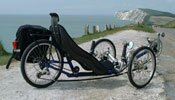

|
Recumbent Types What are the different types of recumbents? Here are the basic types of recumbent bicycles: Long Wheelbase (LWB) — These are the long, chopper-like recumbent models with wheelbases of 60 to 70 inches. They are the most popular type of recumbent available today. The reason is high user-friendliness and reasonably low cost. The LWB’s pedals are behind the front wheel and often are closer to the ground. LWB’s are great all-around recumbents and can be used for most anything. LWB’s with over-seat steering (OSS) are great for commuting, touring, day rides, and sport rides. They can also offer exceptional performance, as Lexan fairings are more effective and easier to mount. There is a newer type of LWB that has a monotube frame, linkage SWB-like steering controls, and higher pedals. These are just as, if not more comfortable, but they don’t perform as well (or adapt to fairings) and are not as user-friendly (higher pedals and more reclined seats). It’s becoming difficult to find LWB’s with under-seat steering (USS). The downside to the LWB is size, storage, transportability, and weight. LWB’s are more difficult to find at dealers. Examples: Sun (EZ), Easy Racers, RANS, Lightfoot, Longbikes Rotator, and Burley. Compact Long Wheelbase (CLWB; aka medium wheelbase or MWB) — The compact LWB with a smaller wheel set (20- inch rear/16-inch front) and a higher seat position. Due to their compact size, and higher riding position, these models make fine entry-level, city and commuter recumbents, though performance is not their forte. Examples: Sun EZ, Cycle Genius, HP Velo Spirit, and Cannondale recumbent. CLWB’s tend to be heavier, have limited gearing (due to the small drive wheel, which can limit performance), and can have more rearward centers of gravity (more weight on the rear wheel; a performance detractor). Short Wheelbase (SWB) — This design has become the choice of the sport riding enthusiast. The reasons are that SWB’s are lighter, more compact, and have a more aggressive design. The wheelbase is shortened by placing the front wheel under or just in front of the rider’s knees and by raising the pedals up to seat height (and higher). The wheelbases are up to 48 inches. This design can offer improved weight distribution, quick road bike-like handling, and lighter weight. The downside is that the SWB can be twitchy (quick) handling and have a longer learning curve. They can also have heel interference with the front wheel during low-speed turns. The higher pedals may require clipless pedals, and there is a greater likelihood for toe/foot numbness for some riders. These models are best suited to more serious cyclists/athletic types. Examples: Bacchetta, RANS, Vision, HP Velo, Burley, Rotator, and Lightning. SWB Lowracer — Imagine being so low that your palms can touch the ground — you’re stretched out, laid back with your feet up high. This is the very fast Euro lowracer. Lowracers were originally based on a lowered and more stretched-out SWB. They were initially only for closed-course racing. More street-rideable models are now appearing. The downside to the lowracer is cost. They are difficult to find in the USA, and there may be fit concerns (short, very tall, and large riders). Safety on low models may be a concern for some riders. These bikes are very low, difficult to see from while riding in traffic, and more difficult for drivers to see them. Examples: HP Velo, Zox, Optima, M5, and Reynolds Weld Lab (semi-lowracer) SWB Highracer — Though relatively new in the USA, these were popular in the late 1980’s in Europe. They’re fast SWB with large-diameter (26-inch, 650c, or 700c) performance wheels that slice through the wind. Lowracers and highracers have laid-back seats and high pedals (extreme riding position). Examples: Vision Saber, Bacchetta Strada, Corsa, and Aero. Recumbent Trikes Delta (two wheels in back): Deltas have one steered front wheel, and usually one of the two rear wheels is driven. Their seats are of average recumbent height (not usually as low as a tadpole). They are best for recreation, cargo, commuting, and touring (though some can be quite fast). Trikes (and trike dealers) can be more difficult to find. Examples: Penninger, Hase, and Lightfoot. Recumbent Tandems The downside of tandems is storage, transportability, and cost. Examples: Sun/EZ, RANS, Barcroft, and Greenspeed (Hase and Penninger offer linked single trikes that make into a tandem). |
|